#Legendary kings of Scotland
Photo
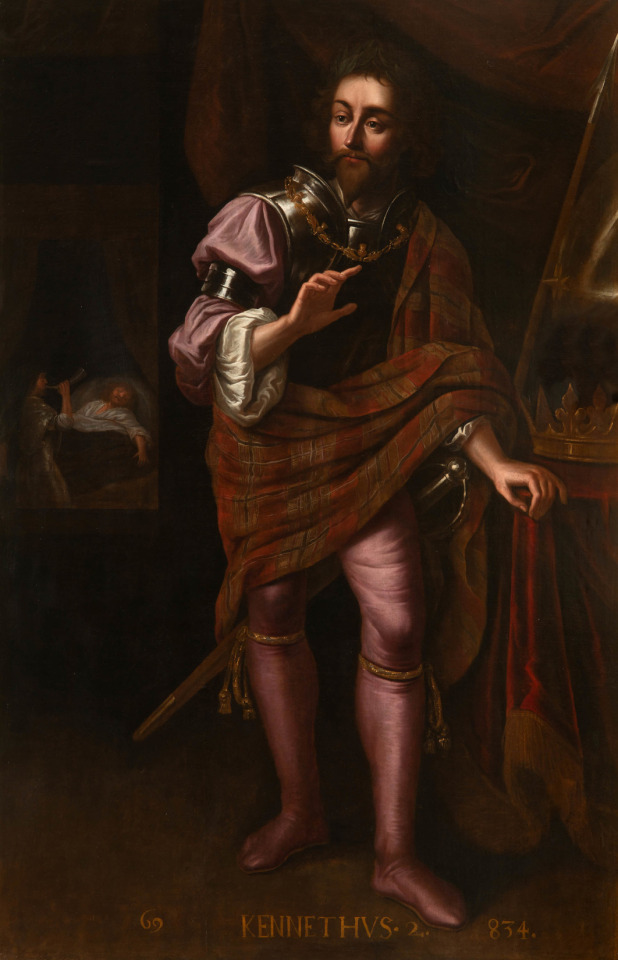
Legendary kings of Scotland by James de Witt.
69: Kennethus II (Kenneth MacAlpin)
Kenneth MacAlpin (810-858) or Kenneth I was King of Dál Riada (841–850), King of the Picts (843–858), and the first King of Alba (843–858) of likely Gaelic origin. He inherited the throne of Dál Riada from his father Alpín mac Echdach, founder of the Alpínid dynasty. Kenneth I conquered the kingdom of the Picts in 843–850 and began a campaign to seize all of Scotland and assimilate the Picts, for which he was posthumously nicknamed An Ferbasach ("The Conqueror").
Kenneth I is traditionally considered the founder of Scotland, which was then known as Alba, although like his immediate successors, he bore the title of King of the Picts. One chronicle calls Kenneth the first Scottish lawgiver but there is no information about the laws he passed.
#kingdom of scotland#kenneth macAlpin#king of scotland#alpínid dynasty#house of alpin#george buchanan#list of scottish kings#legendary kings of scotland#rerum scoticarum historia#list of monarchs#scottish history#kings of dál riata#Chronicle of the Kings of Dál Riata#kingdom of dalriada#kings of the picts#full-length portrait#full length portrait#Coinneach mac Ailpein#Cináed mac Ailpin
7 notes
·
View notes
Text



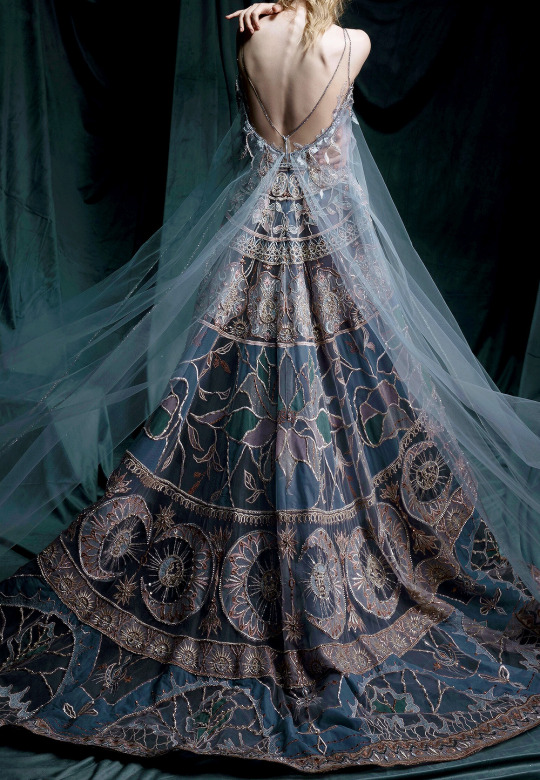
Evermore-Fashion: Celtic Mythology
Guinevere was the wife of King Arthur, the legendary ruler of Britain in Celtic mythology. She was a beautiful and noble queen, but her life took a tragic turn when she fell in love with Lancelot, one of Arthur's bravest and most loyal knights. Guinevere was also the daughter of King Leodegrance of Scotland. Arthur admired the king's lovely daughter and married her in spite of a warning from his adviser Merlin that Guinevere would be unfaithful to him. As a wedding gift, Leodegrance gave Arthur a round table that would play a central role in his court. After the marriage, Guinevere became acquainted with Lancelot, who performed various deeds to honour and rescue her. At first, Arthur took no notice of the growing attachment between the queen and Lancelot. Later, however, the king accused his wife of being unfaithful, and had to Lancelot. Several violent fights between the two followed, with groups of knights joining in on each side. Eventually, Guinevere returned to Arthur.
(The Atelier Couture 'Shakespeare in Love' Bridal Couture Collection)
#FashionEdit#The Atelier Couture#CoutureEdit#Celtic Mythology#FYeahMyths#MythEdit#MythologyEdit#Guinevere#My Edit
2K notes
·
View notes
Text
Today marks a year since we lost the legendary actor Sean Connery.
Born Thomas Sean Connery, in the Fountainbridge area of Edinburgh, Big Tam, he was known growing or as Tommy.
His first job was as a milkman with the St Cuthbert’s Co-Operative Society in Edinburgh. I would think he would have delivered the milk on a horse drawn carriage, the stables for these horses was in the are he grew up, were in Grove Street, where I used to live the main offices for St Cuthbert’s still stands round the corner on Fountainbridge.
Connery also played football at junior level for Bonnyrigg Rose, my cousin played for them too for several years.
A few more facts about Sean are he has a tattoo on his arm that state “Scotland Forever” he got when he enrolled in the Merchant Navy, he was discharged from that job due to stomach ulcers, between jobs he was a nude model for art students at Edinburgh College of art, again not to far from Fountainbridge. Other jobs he took up were, a lorry driver, a lifeguard at Portobello swimming baths, a labourer and a coffin polisher!
I think it is interesting Connery never strayed far from Fountainbridge in his younger days, indeed when he decided that acting was a career he was going to pursue, it was the nearby Kings Theatre he got a job helping backstage, he was also competing in bodybuilding competitions at this time and while at an event in London he learned that there were auditions being held for South Pacific, he was picked to appear on the chorus line but as the production toured the country he was making his way up the ladder.
By the time it hit Edinburgh he had the part of Marine Cpl Hamilton Steeves and was understudying two of the juvenile leads, and his salary was raised from £12 to £14–10s a week, when the production was reprised the following year he had the lead role on the tour, taking over from the actor Larry Hagman, who played the part in London’s West End.
Connery never looked back from there and of course the role of James Bond catapulted him to international stardom, Ian Fleming though was against him getting the part initially, he said Sean was “unrefined” and not what he had in mind, Sean soon won him over though and Fleming later admitted he was an “ideal” Bond.
A few of the parts Sean either didn’t get or turned down are Gandalf, in the Lord of the Rings series of films, he said he never understood the books and also wasn’t keen on 18 months of filming in New Zealand. He also turned down the chance to play the role of the Architect in The Matrix Reloaded and The Matrix Revolutions. Sean was asked to portray King Edward I in Braveheart, but was too busy working on Another film at the time, Patrick McGoohan took the role instead.
His 93rd and last film was 2003’s The League of Extraordinary Gentlemen.
Sir Sean Connery passed away in his sleep on 31st October 2020 at his home in the Bahamas, his son said he had been unwell for some time. The official cause of death was pneumonia, heart failure and old age, his death certificate revealed.
In a career spanning over 50 years, Connery earned an Academy Award, multiple Golden Globes, including the Cecil B. DeMille and Henrietta Awards, as well as two British Academy Film Awards (BAFTA) awards.



67 notes
·
View notes
Text
Arthurian myth: Merlin (1)
Loosely translated from the article "Merlin" of the Dictionary of literary myths, under the direction of Pierre Brunet.

The literary fortune of Merlin was often dependent of the Arthurian literature. However, through its various resonances, the character gained its own seduction and its own popularity that allowed him to return outside of a medieval setting, gaining the status of an autonomous literary myth. He was at first the prophet of the Briton revenge, the one who had initiated the Round Table and who had inspired the errant-knighthood. Through his unique position between good and evil (he is born of a devil and a virgin), between life and death (his paradoxical survival within a “prison of air” or his vault), he embodies in modern times the enigma of History and of the future. Finally, he is the enchanter: causing or suffering many metamorphoses, he is a mythical builder and engineer, and sometimes a warlock/sorcerer. Merlin stays one of the prime heroes of the world of magic.
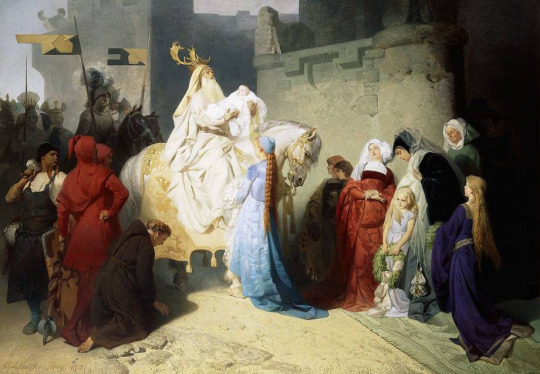
I/ Origins
The name and the character of Merlin appear for the first time within two Latin-written works of the second quarter of the 12th century, by the Welsh cleric Geoffroy of Monmouth: the “Historia Regum Britanniae” (1136) and the “Vita Merlini” (1148).
Nothing allows us to claim that a character named Merlin (Myrddin in Welsh) existed before these works. The very name of Merlin might have been an invention of Geoffroy, based on the name of the city of Kaermyrddin (today’s Carmarthen). It is also possible that Geoffroy used the phonetic similarity between the city and a “Merlin(us)” which belonged to the Armorican tradition (or more largely the continental one). However, Geoffroy of Monmouth did not start out of nothing. In the middle of the 12th century, Robert of Torigny, library of the abbey of Bec, claimed that two Merlin existed: a Merlin Ambroise/Ambrose (Ambrosius Merlinus) and a Merlin Sylvestre/Sylvester (Merlinus Silvester). This opinion was renewed thirty years later by Giraud of Cambria. Thes two names seem to correspond to two different traditions that Geoffroy joined:
1) “Merlin Ambrose” designates a character of the 6th century named Ambrosius. Gildas (in his “De Excidio et conquest Britanniae) made him the descendant of a Roman consulate family. Nennius( “Historia Britonum” presented him as a child born without a father, and whose mother had sex with an incubus – a tradition maintained by posterior authors. Nennius also provided the motif of the child revealing to the king Guorthigirn (Vortigern) the existence of two underground dragons preventing the building of his citadel. Discovered by the agents of the king at Kaermyrddin, the young Ambrosius interpreted the battle of the monsters as the omen of the long battles between the Briton and the Saxon. When Geoffroy retells this scene, he explicitly identifies Merln to this Ambrosius (“Merlinus, qui et Ambrosius dicebatur”).
2) “Merlin Sylvester” appears mainly in the “Vita Merlini”, and he seems to be the heir of older Celtic traditions. These traditions, shared by both Scotland and Ireland, depict a prince who lost his sanity and ran away into the forest, living there a wild existence while gaining supernatural powers. In Scotland it is Lailoken, known through the “Life of saint Kentigern”: on the day of the battle of Arfderydd (located by the “Cambriae Annals” at 573), this character, companion of the king Rodarch, heard a celestial voice condemning him to only have interactions with wild beasts [Translator’s note: The expression in French here is unclear if it speaks of human interactions or having sex, and I unfortunately can’t check the original Life of saint Kentigern right now]. Several predictions were attributed to him, predictions that the “Vita Merlini” places within Merlin’s mouth. Another incarnation of the “Merlin Sylvester” can be find back as early as the 8th century: in Ireland, the legendary king Suibne, turned mad after the battle of Moira, lived in trees (from which he ended up flying away), and shared similar traits with Lailoken. Similarly, in the Armorique there was the prophet Guinglaff, known through a verse-work of the 15th century “Dialogue entre le Roi Arthur et Guinglaff”.

The link between Merlin and those “wild men” becomes even more apparent thanks to several Welsh poems bearing the name “Myrddin”. Three of them belong to the “Black book of Carmarthen” (Welsh manuscript of the end of the 12th century) : The Apple-Trees (Afallenau), the Songs of the Pigs (Hoianau) and the Dialogue between Merlin and Taliesin (Ymddiddan Myrddin a Thaliesin). If the prophetic passages of these texts cannot be older than the Normand invasion, several lines where the bard talks to the trees and animals of the Caledonian forest (especially his pet-boar), complaining about his loneliness and his sorrow, could be the remains of a poem between 850 and 1050, which could be the oldest record of the Merlin legend.
Despite these many obscure origins, it seems that even before the publication of the “Historia Regum Britanniae” Merlin had awakened a certain interest within Geoffroy’s entourage, since Geoffroy decides to publish in 1134, due to the demands of several people including the bishop of Lincoln, a fragment of an unfinished work of his: the “Prophetiae Merlini”. Inspired by the Books of the Sybil, by the Apocalypse and by the prophetic imagery of Celtic and Germanic tribes, these “Prophecies”, that Geoffroy claimed to have translated from the language of the Briton, is first a record of several events that happened in Great-Britain since the Saxon invasion until the reign of Henry the First. Then, they announce in an obscure fashion the revenge of the Briton, and a series of disasters prefacing the end of the world. This text was a huge success: until the end of the Middle-Ages, these “Prophecies” were commented and quoted as equals to the holy Christian books. Alain of Lille, the “Universal Doctor”, wrote a commentary of the Prophecies in seven books. Merlin, first the great prophet of Wales, then of Scotland, was adopted in the 14th century by the England, which completely forgot the anti-Saxon origins of the character, and took the habit of beginning almost every speech by quoting a Prophecy of Merlin.
The ”Historia Regum Britanniae”, after the story of the two underground dragons and the text of the Prophecies, attributes to Merlin the building of Stonehenge, in the memory of Briton princes treacherously killed. Finally, it tells of how the prophet gave to the king Uter Pendragon magical potions that gave him the appearance of the husband of the duchess Ingern. A trick that allow the birth of the future king Arthur. As early as this first work, Merlin appears at the same time as a prophet and a wizard: a character claims that no one can rival with him when it comes to predicting the future, or accomplish complex machinations (“sive in futuris dicendis, sive in operationibus machinandis).
The ”Vita Merlini”, told in verse, completes Merlin’s biography by telling adventures of a very different tonality. Seer and king in the south of Wales, Merlin became mad after a deadly battle, and lived in the woods like a wild beast. Only the music of a zither can appease him. Led to the court of king Rodarch, chained in order to be kept there, he proves his gift of second sight throughout several “guessing scenes”. Before returning to the woods, he agrees to letting his wife Guendoloena marry again. However, on the day of the wedding, he appears with a horde of wild beasts, riding a stag. Ripping one of the antlers of his ride, he uses it to break the head of Guendoloena’s new husband. The rest of the text depicts Merlin as being saved by his sister Ganieda: he performs a series of astronomical observations and makes prophecies about the future of Britain. His disciple Thelgesin (identified with the Welsh bard Taliesin), back from the Armorique, joins him and they talk lengthily about nature. Finally, Merlin regains his sanity thanks to the water of a stream that just appeared, but he refuses to rule again and stays faithful to the forest.
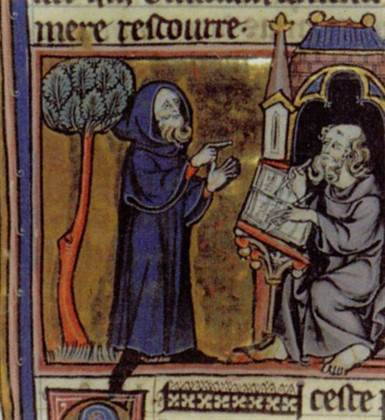
26 notes
·
View notes
Note
If I wanted to get really into medieval welsh literature instead of just reading everything in our beloved Hergest duo, do you have any recommendations on where to begin?
hi! sorry it took me so long to answer this but hopefully the length of the answer means it's worth the wait. by "our beloved hergest duo" i'm assuming you mean the white book of rhydderch and the red book of hergest, and more specifically the texts collected as the mabinogion from those two manuscripts - if i'm wrong let me know. i'm also assuming that you mainly want to read in english translation, at least to start with.
there is a LOT of medieval welsh literature out there beyond the mabinogion but a lot of it is harder to access. this is a rough menu of options with my honest opinions about how easy it is to get at these things:
the triads of the island of britain (trioedd ynys prydein), aka a big long list of People And Things From Welsh Tradition (Some Possibly Made Up). for this you want rachel bromwich's edition and translation: there are four different editions of this and all of them are expensive (and three of them are out of print). i recommend keeping an eye out on secondhand book websites for the 2nd edition (1978) or the 4th (2014), or bugging your library to see if they have, or will buy, either of these. if you're currently at uni you may be able to get access to an electronic version of the 4th edition.
material about merlin. maybe start with geoffrey of monmouth's latin vita merlini - this is less a reflection of welsh tradition and more an extremely lengthy riff on it, but still very interesting. a new translation of it can be found here! medieval merlin material in welsh is basically all prophetic poetry, mostly from the black book of carmarthen. at the moment, the best place to find translations of this is in the romance of merlin, ed. peter goodrich (1990) - again i recommend looking out for a secondhand copy or talking to your library. hopefully the myrddin project at cardiff will soon have fresh editions and translations for us available online! (in the meantime, here's their twitter.) there's also armes prydein vawr, a somewhat different type of prophecy poem also associated with merlin/myrddin and generally dated to the 10th century, which you can find on archive.org here.
material associated with taliesin. this comes in many shapes and sizes. first of all, there's praise poetry attributed to taliesin and addressed to the 6th-century king urien of rheged: this is mostly translated in the two clancy anthologies i'm going to cite further down, but if you want the welsh text, the best place to find it is probably in ifor williams' edition (translated into english as the poems of taliesin by j. e. caerwyn williams, available from the dublin institute for advanced studies). second of all, there's All The Other Poetry Attributed To Taliesin: for this you want marged haycock's legendary poems from the book of taliesin and prophecies from the book of taliesin. again with these i recommend the secondhand or library approach. THIRD of all, there's a relatively late folktale about taliesin (this is where ceridwen and gwion bach come in): this you can find translated in patrick k. ford's the mabinogi (which it looks like you can get as a kindle or paperback comparatively cheap).
y gododdin, the massive poetic text attributed to aneirin about A Lot Of Dead Dudes In Southern Scotland. this is a tough one to get to grips with, i'm not gonna lie. if you want to get at the welsh text, the massive modern welsh edition by ifor williams (canu aneirin) is still the best there is, but he reorders the stanzas of the poem from the manuscript pretty radically. (to see the stanzas in order, look for daniel huws' facsimile edition of the book of aneirin - or, depending on how well you read medieval welsh handwriting, check out the manuscript itself.) for translations, i recommend joseph p. clancy's, which has multiple versions floating around - there's one in the triumph tree (ed. thomas owen clancy) and a slightly less full one in medieval welsh poems (joseph clancy's big anthology, now out of print). this is the most poetic while still being largely accurate, but if you're concerned about academic levels of accuracy, then i recommend balancing clancy out with kenneth jackson's the gododdin: the oldest scottish poem, which has the advantage of being designed to be used alongside ifor williams. FOR ALL OF THESE you'll need to hit up secondhand booksellers or libraries.
early welsh englyn poetry: by this i mean poetry in englyn metre about historic figures and landscapes. as academic sources/translations, if you can get your hands on them, i recommend jenny rowland's early welsh saga poetry (1990) and patrick sims-williams' new englynion y beddau (2023), but both of these are massive and expensive. a more approachable way to get at this material may be rowland's a selection of early welsh saga poems, which is intended more for classroom use - this you can get for relatively cheap as a paperback. you might also want to check out kenneth jackson's studies in early celtic nature poetry (dated, but i think he translates some of the less-studied englyn poetry in there: again, check with secondhand booksellers) and nicolas jacobs' early welsh gnomic and nature poetry (cheaper and easier to get, but untranslated, though he gives a useful glossary so you can attempt it yourself).
additional arthurian material. this is scattered across various places and manuscripts, but some good places to learn about it, if not necessarily read it, are o. j. padel's arthur in medieval welsh literature (2013, heavily recommended, you can get it cheap as a paperback); bromwich et al's the arthur of the welsh (1991), which iirc includes patrick sims-williams' translation of my beloved arthurian poem pa gur; and the new and exciting arthur in the celtic languages, ed. ceridwen lloyd-morgan and erich poppe (2019), which is going to give you a BIG and comprehensive overview of every text arthur has ever shown up in in welsh. for the last two you definitely want to go secondhand or through a library.
high and late medieval poetry of praise, lament and love: the bread and butter of the professional poet. these can be found in various places. for the gogynfeirdd, the high medieval poets, the medieval welsh texts (+ modern welsh paraphrases) can be found in the absolutely massive series cyfres beirdd y tywysogion, but this is not something to attempt to get without a powerful library on your side. the late medieval poetry, on the other hand, is edited in cyfres beirdd yr uchelwyr and can be found online here - which was news to me! much of this material has never been translated into english. for a good selection of translations of some of the best stuff, i really recommend joseph p. clancy's medieval welsh poems (find a secondhand copy or get your library to do it for you), and/or tony conran's welsh verse. a couple of good selections of the later medieval poetry are: the poetry of dafydd ap gwilym, ALL of which is available online in translation here; loomis and johnston's medieval welsh poems: an anthology; and dafydd johnston's galar y beirdd: poets' grief, which specifically collects poets' laments for their dead children.
RELIGIOUS MATERIAL, of which there is a shit-ton. my recommendations are definitely going to be missing some stuff (e.g. soul-and-body dialogues, descriptions of purgatory, etc) but here's what i've got. for material to do with welsh saints, i recommend this website, where you can find translations of a lot of the latin prose lives of saints and quite a few welsh poems about saints as well - and if you look at the bottom you'll see it lists a few more books you might want to look into. if you want an even fuller look at welsh saints' latin lives, albeit dated, see if you can get your hands on a secondhand/library copy of wade-evans' vitae sanctorum britanniae (1944). if you like genealogies, barry lewis i believe has just put out an edition and study of bonedd y saint, the genealogies of the welsh saints, available from the dublin institute for advanced studies (though it's not the cheapest thing out there).* there is also a lot of general religious poetry, which you can find edited in marged haycock's blodeugerdd barddas o ganu crefyddol cynnar (1994) and translated in mckenna's the medieval welsh religious lyric (1991).
*i should also say that if you're interested in medieval welsh genealogies in general, you want ben guy's medieval welsh genealogy - this is very technical and probably expensive but if you really need to know who's related to who in the welsh historical imagination, it's a great resource.
(pseudo-)historical texts: there are various of these. the most famous is geoffrey of monmouth's de gestis britonum (also known as historia regum britanniae, 'history of the kings of britain') - this you can find edited and translated by reeve & wright under the latter title. if you want to know about geoffrey's work but you can't get your hands on it or don't have time to read what is honestly a massive text, then i recommend karen jankulak's book geoffrey of monmouth - super useful and you can get it cheap as a paperback. then there are medieval welsh translations of this text (all known as brut y brenhinedd), some of which go on to become chronicles in their own right (brut y tywysogion). off the top of my head there are three different versions of brut y tywysogion which you can find in a good english translation: the peniarth 20 version (edited and translated by thomas jones, edition 1941, translation 1952); the red book of hergest version (ed. and trans. thomas jones, 1955); and brenhinedd y saesson (ed. and trans. thomas jones, 1971). you might also want to check out the medieval biography of gruffudd ap cynan (king of gwynedd 1081-1137), which starts as a latin text and is later translated into welsh. the latin text is edited and translated by paul russell as vita griffini filii conani (2005); the welsh text is edited as historia gruffud vab kenan (1977) and translated as a mediaeval prince of wales: the life of gruffudd ap cynan (1990) by d. simon evans.
edited to add: [LOUD BUZZER SOUND] I FORGOT ABOUT HISTORIA BRITTONUM AND SHOULD BE PUBLICLY SHAMED. this is a ninth-century latin historical text from north wales, it's weird as hell, i love it to bits and should probably actually read more of it. currently the edition everybody uses is john morris's nennius: british history and the welsh annals (1980), which is not the most expensive thing out there but certainly not the cheapest so get it through your library if you can. this is especially useful in conjunction with geoffrey's de gestis britonum because he was absolutely using it as a source.
the hardest thing to get at on this list: translation literature. by the time we get to the red book of hergest there's been a huge boom in medieval translations of french and latin texts into welsh - and these are often really fun and interesting to read, but under-studied! this is an issue because it means i basically cannot recommend you any english translations of them. if you're still interested and you want to plough through the medieval welsh yourself, here are some texts:
cân rolant, a welsh version of the 'song of roland' aka Violence Violence Violence, edited and translated by a. c. rejhon (1984) - the only thing on this list to have a recent translation, alas;
ystorya de carolo magno, edited by stephen williams, 2nd edition (1986) - a welsh version of the charlemagne legend, this is where cân rolant comes from;
ystoryaeu seint greal, a welsh translation of two french romances, queste del saint graal and perlesvaus: you can find the whole thing in the (very old, undoubtedly outdated) selections from the hengwrt mss volume 1, y seint greal, edited and translated by robert williams (1874-6), which is on archive.org here, and the welsh text of the first part is edited as y keis by thomas jones (1992);
ystorya bown de hamtwn, a welsh version of the romance of bevis of hampton, an absolutely insane text about the worst man in the world which i love dearly: the whole thing is edited (but not translated) by morgan watkin (1958); selected bits of it are edited with a useful glossary for classroom use by erich poppe and regine reck as selections from ystorya bown o hamtwn (2009);
a welsh bestiary of love, ed. g. c. g. thomas (2008) - a translation of the french bestiaire d'amour, aka Do You Want To Hear The Worst Man In The World Tell You Dubious Animal Facts? Of Course You Do;
kedymdeithyas amlyn ac amic, edited by patricia williams (1982), a welsh version of the french tale ami et amile about two identical friends;
chwedlau odo, a collection of fables, edited by ifor williams (1958);
chwedlau seith doethon rufein, edited by henry lewis (1958) - 'stories of the seven sages of rome'.
and finally, medical texts! if you want a look at medieval welsh medical practices and you want to learn a lot of plant names in middle welsh, check out diana luft's medieval welsh medical texts, which you can find online for free here.
i hope this is helpful! enjoy Experiencing Welsh Literature and best of luck getting your hands on it!
16 notes
·
View notes
Photo
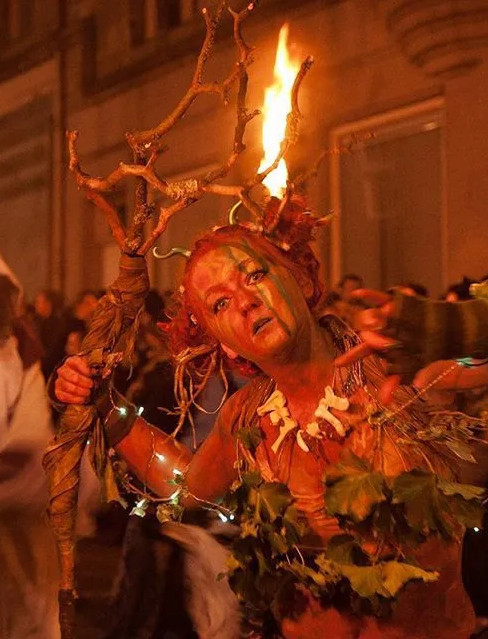
[Photo above: Samhain, courtesy of Beltane Fire Society]
Legends and myths about trees
Legendary tree deities (22)
Hyldemoer – 'the Elder Mother’, the guardian of the elder trees
“If you stand beneath an elder tree on midsummer eve you will see the King of the faeries and his entourage but be careful that you do not get swept away to faerieland.
The tree and the wood is greatly prized by the fae folk, so it must not be used to make mundane household objects, especially not a cradle or the baby will be pinched black and blue.
Do burn the wood or bring it into the house as this is very unlucky and will bring the devil in.
The Elder Mother guards the tree and although she is usually kind she can become dangerous, if her trees are harmed so you must always ask permission before cutting an elder tree.
To cut elder wood you must say, three times, ‘Elder Mother, please give me some wood, and I’ll give you some of mine when I grow into a tree (Ourd gal, give me some of thy wood, an oi will give some of moine, when oi grows inter a tree)’.”
Faeries and Folklore from the British Isles
The Elder Mother is thought to be the guardian of the elder trees, and it was said, until recent times in various parts of England and Scandinavia that to take wood from the elder tree one would have to ask the Elder Mother first, or else ill luck would befall the woodsman. The spirit is said to haunt or torment people who build from elder wood unless they ask permission first.
In Denmark, the Hyldemoer (“Elder-mother”) or Hyldequinde (“Elder-woman”) is a spirit like a wood-nymph or dryad that lives in the elder tree.
Other similar and related beliefs have been handed down in various cultures.
In Denmark, an elder twig put in the mouth was traditionally thought to drive out evil spirits and thus could cure toothache. Also in Denmark, on Midsummer's Eve, if you were to stand under an elder, you could see the Elf-king and his host. A similar tradition existed in Scotland where it was said to happen on All Hallows or Samhain.
In England, it was thought that the elder tree could never be hit by lightning and that carrying the twigs of an elder could protect their bearer from rheumatism. Farmers used to protect their animals from evil by placing a cross made from elder on their cow-sheds and barns.
In some Slavic countries, such as Russia, it is thought that the tree had the power to ward off evil. In Sicily, it was claimed to have the power to ward off snakes, and so on.
Every summer, our neighbourhood had an elder hedge with divine, full blossoms, but it was completely cut down to develop a residential site. These days, they spray the stumps with powerful chemicals to prevent regrowth.

木にまつわる伝説・神話
伝説の樹木の神々 (22)
ヒルデモア-「エルダー・マザー」、ニワトコ (エルダー) の木の守り神
“真夏の夜、ニワトコの木の下に立つと、妖精の王とその一行を見ることができる。でも、妖精の国に流されないように気をつけて。
この木と木材は、妖精たちにとても珍重されている。だから、ありふれた家庭用品を作るのに使ってはいけない、特にゆりかごは厳禁だ。さもないと、赤ん坊は青黒く痣が付くまでつまんで痛めつけられる。薪を燃やしたり、家の中に持ち込んだりしてはいけない。これは非常に不吉で、悪魔がやってくるからだ。
エルダー・マザーは木を守っている。彼女は普段は優しいが、ニワトコの木に危害を加えると危険な存在になる。だから、ニワトコの木を切る前には、必ず許可を得ること。
『ニワトコのお母さま、私にあなたの薪をちょうだい。私が木に成長したら、私の薪も差し上げます』と、3回唱えなければならない。”
ブリテン諸島の妖精と民間伝承より
エルダー・マザーはニワトコ(エルダー)の木の守り神であると考えられており、イギリスやスカンジナビアの各地では最近まで、ニワトコの木から木材を取るにはまずエルダー・マザーに許可を得なければならず、さもなければ木こりに不運が降りかかると言われていた。その精霊は、まず許可を得なければ、ニワトコの木で建物を建てた人に取り憑いたり、苦しめたりすると言われている。
デンマークでは、ヒルデモア(「ニワトコの母」)またはヒルデキンデ(「ニワトコの女」)は、ニワトコ(エルダー)の木に住む木の妖精やドライアドのような精霊である。
このほかにも、さまざまな文化圏で似たような信仰が受け継がれている:
デンマークでは伝統的に、ニワトコの小枝を口に入れると悪霊が追い出され、歯痛が治ると考えられてきた。またデンマークでは、夏至祭の夜にニワトコの下に立つと、エルフの王とその群れが見えるとされていた。スコットランドにも同様の伝統があり、万聖節(All Hallows)またはサウィン祭(Samhain)に起こると言われていた。
英国では、ニワトコの木は雷に打たれることがなく、ニワトコの小枝を持っているとリューマチから身を守れると考えられていた。農家では、ニワトコで作った十字架を牛小屋や納屋に置くことで、家畜を悪魔から守っていた。
ロシアなどのスラブ諸国では、この木には魔除けの力があると考えられていた。シチリアでは、蛇を追い払う力があるとされていたなどなど…。
毎年夏になると、近所にニワトコの生け垣があり、神々しいほどの満開の花を咲かせていたが、宅地開発のために完全に切り倒されてしまった。最近では、再生を防止するため、切り株に強力な化学薬品を撒くらしい。
#trees#tree legend#tree myth#elder mother#hyldemoer#elder wood#elder trees#legend#folklore#mythology#all hallows#samhain#fairy#fairy tree#nature#art
100 notes
·
View notes
Text
Naoise / ノイッシュ, Arden / アーダン, and Alec / アレク
Naoise (JP: ノイッシュ; rōmaji: noisshu; romanization: Noish) is a knight of the Grünritter who joins Sigurd in his journey in Fire Emblem: Genealogy of the Holy War. He is named after the character of Naisi, called Naoise in modern Irish, from the Tragic Tale of the Sons of Uisnech, a section of the Táin Bó Cúailnge. He became the lover of Deirdre, a woman who already promised to wed Conchobar mac Nessa—the king of Ulster. They fled to Alba, that is, Scotland, to escape Conchobar's wrath, and later hid on an adjacent isle upon the Alban king learned of Deirdre's beauty. The people of Ulster dearly missed Naoise, and Conchobar gave into the populace's desires, sending Fergus mac Róich as an envoy to bring the couple back. This plan was sowed with evil from the start; soon after Naoise and Deirdre meet Conchobar, battle breaks out. By the conclusion, Naoise is dead, and Conchobar takes Deirdre to be his wife.
The character of Sigurd, being the husband of Genealogy's Deirdre, has a handful of parallels with Naoise, from his exile from Grannvale to his wife being taken by the one who plots against him. This connection is made even more direct by naming his knights after the sons of Uisnech.
That's right: Naoise had two brothers with minor roles in the story, serving as the namesakes of Sigurd's two other knights. Arden (JP: アーダン; rōmaji: Ādan) is named after the youngest of the three brothers, Ardan. That leaves Alec (JP: アレク; rōmaji: areku) to be the middle child, Ainle. Even if you don't understand Japanese, you probably can tell something is off here. And you're right: Ainle is supposed to be rendered as アンリ (rōmaji: anri)—the same name as the legendary wielder of Falchion, Anri. Likely to avoid stepping on the toes of another continent's lore, the name was changed. I do wonder why such a drastic change was made; I don't think something like アンレ (rōmaji: anre) would have been problematic.
The sons of Uisnech all fell in that conflict against Conchobar; some tellings claim they were killed simultaneously, decapitated with Naoise's sword, granted to him by the god Manannán mac Lir, or run through by a single pike. Of course, all three of these Grünritter were slain in the Battle of Belhalla.
10 notes
·
View notes
Note
I feel that BRAN is actually the "Queen Elizabeth I" of the story & a child by Sansa/Jon would be the King James I of England (6th of Scotland)
Oh Esther thank you so much for the shout out. I am not an expert by any means but I think anon is onto something here.
1. Sansa shares clear parallels with Elizabeth I but she also shares parallels with Bran:
A. Both are unlikely heirs, having an older sibling who reigns. Robb, like Mary Tudor, married against the wishes of their council to someone who was profoundly disliked.
B. Any jonsa kid would be “of the North” which is roughly the Westerosi equivalent of Scotland so, parallel with James.
C.A jonsa child would be Brandon’s nephew, just as James was of Elizabeth.
D. A jonsa child would technically be both the northern heir AND the southern heir, therefore uniting BOTH crowns. This way the North wouldn’t be giving up their independence.
E. Both lost their mother at an early age and had to deal with responsibilities beyond their years. James was also a very young King.
F. A funny tidbit is that James’s mother was considered a great beauty, and her embroidery skills were legendary, just like Catelyn’s.
The way I see it, Brandon is not Elizabeth but the York King, if he had lived. GRRM is writing the war of the Roses with a flipped ending where the Yorks=Starks win and not the Tudors=Targaryens.
(about this ask)
Thank you for the additional thoughts, @minitafan!
51 notes
·
View notes
Note
hiii can you please recommend me some gay novels ? thank you in advance :)
hell ! yeah !
you didn't really specify what genre you're interested in beyond gay so i'm just gonna rec my favs and go wild with it. apologies, i've prob. recced these books before but *shrug*
edit: i added books that aren't novels cos i couldn't resist. ooops?
edit 2: i've taken gay to mean gay ~umbrella term~ and not gay mlm, hope that's alright x
under a read more cos i got carried away !
the raven cycle | maggie stiefvater | completed series | ya | fantasy | follows blue sargent, the daughter of a skilled psychic who augments her family's abilities, but has no psychic power of her own. she becomes friends with four boys from the local boarding school -- gansey, adam, ronan and noah -- when she meets gansey's ghost and learns the upcoming date of his death. gansey is obsessed with finding the sleeping welsh king, glendower. In his pursuit of the legend, he and his friends encounter all kinds of mysticism and danger in henrietta, virginia.
the dreamer trilogy | maggie stiefvater | completed trilogy | ya | fantasy | raven cycle sequel focusing on ronan's character.
the disasters | mk england | ya | sci fi | star trek vibes | found family | a band of space academy rejects are the only witness to a terrible crime/galaxy-wide conspiracy & are the only ones who can save the day.
emry merlin series | robin schneider | incomplete trilogy | ya | fantasy | arthuriana | a knight's tale meets bbc merlin | years after her father’s, legendary court wizard merlin, disappearance, emry takes her far less talented twin brother’s place when he is summoned to camelot to train and become prince arthur’s right hand wizard. studying magic properly is everything she hoped for, but posing as her brother isn’t as easy as it seems. not to mention those sparks that are flying between her and arthur.
cemetery boys | aiden thomas | standalone -> a sequel is planned | ya | fantasy | trans rep | yadriel wants to prove himself as a brujo (and a man) to his family so, in secret, he performs the ritual meant to unlock his powers that his family has denied him access to. only problem, he’s accidentally summoned a ghost he didn’t mean to and the guy won’t leave. also his cousin vanished and his spirit is nowhere to be found.
the last binding series | freya marske | incomplete trilogy -> the third one is coming out in november | historical fantasy | alternative edwardian england | romance | each book focuses on a new queer pairing while following an overarching mystery | when an administrative mistake names robin blyth as a civil service liaison to a hidden magical society, he discovers what’s been operating beneath the unextraordinary reality he’s always known. a dangerous deadly curse awaits him as he navigates the magical bureaucracy with his standoffish counterpart edwin courcey.
the kingdoms | natasha pulley | standalone | historical fantasy | time travel | alternate history | 19th c. | 18th c. | joe tournier has amnesia. he remembers nothing prior to stepping off a train in londres, england, a french colony. his only clue, a century-old postcard of a lighthouse in scotland, illegally written in english rather than french and signed m.
the watchmaker of filigree street series | natasha pulley | completed duology | historial fantasy | 19th c. | sherlock holmes vibes | telegraphist thaniel receives a mysterious watch on his birthday whose pre-set alarm saves him from a terrorist bombing on scotland yard. since the bomb was made with clockwork parts and only the bomber could have known when to set the alarm, thaniel is sent by a detective investigating the bombing to live with the suspected watchmaker to figure out what’s going on.
the bedlam stacks | natasha pulley | standalone -> twofs references/characters but not part of the main storyline | historical fantasy | 19th c. | magical realism | merrick tremayne is called upon by the india office to go on a dangerous expedition deep in peru to fetch quinine (essential for the treatment of malaria) despite the debilitating injury that almost cost him a leg. every expedition before his has yielded no results apart from dead bodies, but merrick has family history deep in the country so he goes against his better judgement. there, he meets raphael, a priest surrounded by strange stories of disappearances, cursed woods and living stones, and who might hold the key to his family’s past.
the binding | bridget collins | standalone | historical fantasy | 19th c. | romance | in a world where books are dangerous objects containing people’s painful memories they want to get rid of, emmet farmer is sent to become an apprentice to the local bookbinder after he had some sort of mental collapse.
captive prince series | cs pacat | completed trilogy + some short stories | historical fantasy | romance | no magical elements | dark themes | major trigger warnings apply | prince damianos of akielos is sent as a pleasure slave to laurent of vere, prince of an enemy neighbouring kingdom, by his treacherous half-brother who wants the throne for himself. the court of vere is a pit of deception and lies and both princes must reluctantly ally with each other to gain rightful control of their respective kingdoms. only problem, damen killed laurent's older brother auguste in battle and must keep his true identity secret to protect himself from laurent's hatred of his brother's killer. which is only complicated by the growing feelings between them.
a taste of gold and iron | alexandra rowland | standalone | historical fantasy | romance | kadou, the shy prince of arasht, has no intention of wrestling for imperial control with his sister, the queen. yet he remains at odds with one of the most powerful ambassadors at court - the father of the queen's new child. when a hunting party goes terribly awry and he finds himself under suspicion of attempted murder, kadou teams up with his new bodyguard, the coldly handsome evemer, to investigate a break-in at one of their guilds to salvage his reputation. but what appears to be a straightforward crime spirals into a complex counterfeiting operation, with a powerful enemy at its heart.
the house in the cerulean sea | tj klune | standalone | fantasy | romance | found family | 40 yo caseworker linus baker is given a special secret assignment to check out an orphanage of supposedly particularly dangerous magical children. linus has been a rule follower and someone who doesn’t want to rock the boat his whole life, but the children and their caretaker make him reconsider previously held beliefs.
under the whispering door | tj klune | standalone | fantasy | romance | found family | an unpleasant and selfish man in life, wallace price meets his reaper at his near-empty funeral and gets taken to a whimsical tea shop where he meets hugo, the ferryman whose job it is to help him move on and crossover into the afterlife. a task that becomes complicated as wallace starts developing feelings for hugo.
peter darling | austin chant | standalone | historical fantasy | romance | trans rep | peter pan retelling | ten years ago, peter pan left neverland to grow up, leaving behind his adolescent dreams of boyhood and resigning himself to life as wendy darling. growing up, however, has only made him realize how inescapable his identity as a man is.but when he returns to neverland, everything has changed: the lost boys have become men, and the war games they once played are now real and deadly. even more shocking is the attraction peter never knew he could feel for his old rival, captain hook—and the realization that he no longer knows which of them is the real villain.
the song of achilles | madeline miller | standalone | historical fantasy | mythology retelling | greek mythology | a classic ! | achilles' story, great love, and tragedy...
salt magic skin magic | lee welch | standalone | historical fantasy | 19th c | lord thornby has been trapped on his father’s estate by a strange curse for a year and when industrial magician john blake shows up, they must team up to investigate the mystery.
the secret lives of country gentlemen | kj charles | first in a series | historical romance | regency era | a shabby london clerk who inherits a grand house on the remote romney marsh is unexpectedly reunited with an old lover and gets unexpectedly thrown in the world of smugglers.
the will darling adventures | kj charles | completed trilogy | historical romance | 1920s | it’s the 1920s and tensions are rising along with hemlines. soldier-turned-bookseller will darling finds himself tangled up in spies and secret formulas, clubs and conspiracies, bbolsheviks, blackmail, and bright young things. and dubious aristocrat lord arthur ‘kim’ secretan is right in the middle of it all: enigmatic, unreliable, and utterly irresistible.
the gentleman’s guide to vice and virtue | mackenzie lee | ya | historical romance | 18th c. | bisexual disaster nobility youth goes on his grand tour on europe with the best friend he has a crush on and his sister. nothing could possibly go wrong.
the seven husbands of evelyn hugo | taylor jenkins reid | historical romance | old hollywood | 1950s | 1960s | 1970s | aging and reclusive hollywood movie icon evelyn hugo is finally ready to tell the truth about her glamorous and scandalous life. but when she chooses unknown magazine reporter monique grant for the job, no one is more astounded than monique herself. why her? why now?
the charm offensive | alison cochrun | standalone | contemporary romance | reality dating show producer dev has always believed in romance/fairy tales and he works tirelessly to ensure magical happy endings happen on his show, even though his own love life is a disaster. but when disgraced tech wunderkin charlie is cast as the lead of their next season, dev has his work cut out for him to transform charlie into a man the ladies on the show might want and the viewers might like. charlie is far from a prince charming but as they get closer and closer, dev starts realising he might want him for himself. uh oh.
i kissed shara wheeler | casey mcquiston | standalone | ya | contemporary romance | a month before graduation, chloe green’s academic rival shara kisses her before disappearing. now, chloe is on a hunt for answers alongside unlikely allies.
one last stop | casey mcquiston | standalon | contemporary romance | time travel | a 23-year-old realises her subway crush is displaced from 1970's brooklyn, and she must do everything in her power to help her - and try not to fall in love with the girl lost in time - before it's too late.
red, white, and royal blue | casey mcquiston | contemporary romance | new adult | alex, son of the us president, and british prince henry have to fake a pr friendship after a scandal at a royal wedding puts us-british relations at risk. only problem? they despise each other.
check please | ngozi ukazu | graphic novel | new adult | contemporary romance | coming of age | bitty, a southern ex-figure skater armed with a love of baking and a vlog joins his college’s hockey team and falls for his captain, the prodigal son of a famous nhl player whose own draft was derailed by an overdose of anxiety medication.
angels in america | tony kushner | theatre | aids | angels in america is the story of a gay man, prior alter, a 30-year-old New Yorker, whose lover, louis, abandons him when he falls ill with aids. transcendent forces—visions and angels—help transform Prior from a man dying of aids to a man living with aids. along the way, several romantic and platonic couples come apart, and the final social configuration of the play comprises a loose band of multi-generational, multiracial, queer friends.
the normal heart | larry kramer | theatre | aids | focuses on the rise of the hiv/aids epidemic in nyc between 1981 and 1984, as seen through the eyes of writer/activist ned weeks, the gay founder of a prominent HIV advocacy group.
love song to lavender menace | james ley | theatre | in 1982, two friends bob and sigrid opened their new radical lesbian, gay and feminist bookshop, 'lavender menace' on edinburgh's forth street. on the eve of the shop's 5th birthday, sales assistants paul and david take a look back at its origins, in this funny, moving play.
this is how you lose the time war | amal el-mohtar & max gladstone | sci fi | literary fiction | epistolary novel | time travel | an epistolary story told by two future beings, operatives on opposing sides of the "time war" tasked with ensuring that past events happen in ways that are amenable to their goals.
on earth we're briefly gorgeous | ocean vuong | literary fiction | epistolary novel | a letter from a vietnamese american son to his illiterate mother.
night sky and exit wounds | ocean vuong | poetry
time is a mother | ocean vuong | poetry
crush | richard siken | poetry
brokeback mountain | annie proulx | short story | two ranch hands, come together when they're working as sheepherder and camp tender one summer on a range above the tree line. at first, sharing an isolated tent, the attraction is casual, inevitable, but something deeper catches them that summer.
fighting proud: the untold story of the gay men who served in two world wars | stephen bourne | non-fiction | history | wwi | wwii
coming out under fire: the history of gay men and women in world war two | allan bérubé | non-fiction | history | wwii
fabulosa!: the story of polari, britain’s secret gay language | paul baker | non-fiction | history | linguistics | 19th c. | 20th c.
36 notes
·
View notes
Text
Day 6: Friday, 12th July — Favorite fictional medieval woman (example: women from Arthurian legends, Maid Marion, a fictional character from a novel, movie, or TV series set in the Middle Ages): Queen Guinevere


Guinevere was the wife of King Arthur , the legendary ruler of Britain. She was a beautiful and noble queen, but her life took a tragic turn when she fell in love with Lancelot , one of Arthur's bravest and most loyal knights. The relationship between the queen and Lancelot eventually destroyed the special fellowship of the Knights of the Round Table.
Guinevere was the daughter of King Leodegrance (pronounced lee-oh-duh-GRANTZ) of Scotland. Arthur admired the king's lovely daughter and married her in spite of a warning from his adviser Merlin that Guinevere would be unfaithful to him. As a wedding gift, Leodegrance gave Arthur a round table that would play a central role in his court.
After the marriage, Guinevere became acquainted with Lancelot, who performed various deeds to honor and rescue her. At first, Arthur took no notice of the growing attachment between the queen and Lancelot. Later, however, the king accused his wife of being unfaithful, and had to fight her lover. Several violent batdes between Arthur and Lancelot followed, with groups of knights joining in on each side. Eventually, Guinevere returned to Arthur.
Another group of legends concerning Guinevere show the queen in a more loyal role. In these tales, King Arthur left his nephew Mordred in charge of the kingdom during a military campaign. Mordred began to plot against Arthur, planning to marry Guinevere and take over as ruler of Britain. The queen refused to cooperate with Mordred and locked herself in the Tower of London to avoid marrying him. When Arthur returned to reclaim his throne, the two men fought. Arthur killed Mordred but was fatally wounded.
Following the death of Arthur, Guinevere entered a convent, where she spent the rest of her life praying and helping the poor. Filled with remorse for the trouble she and her lover had caused, she vowed never to see Lancelot again. When Guinevere died, she was buried beside King Arthur.
Guinevere in Context
The story of Guinevere can be seen as a reflection of medieval European beliefs about adultery. The affair between Guinevere and Lancelot is the root cause of the fall of Camelot , since all other events leading to Arthur's downfall stem from this betrayal. Guinevere is typically portrayed more negatively than Lancelot, suggesting that women— especially married women—were expected to live by a higher moral standard than the men of the time.
Key Themes and Symbols
Throughout the myths of King Arthur and his court, Guinevere represents both loyalty and betrayal. She is seen by the people of Camelot as a devoted supporter of her husband's deeds and ideas. Even after she betrays Arthur by having an affair with Lancelot, Guinevere regrets the betrayal and stays with Arthur, devoting herself to no other man even after his death.
Guinevere in Art, Literature, and Everyday Life
Guinevere appears in nearly every adaptation of the legend of King Arthur, including Sir Thomas Malory's Le Morte d'Arthur, T. H. White's The Once and Future King, and the Avalon series of novels by Marion Zimmer Bradley. On film, she has been played by actresses such as Ava Gardner, Vanessa Redgrave, and Keira Knighdey. Guinevere has also appeared as the main character in a number of works, including the Guinevere Trilogy novels by Persia Woolley and the television series Guinevere Jones (2002).


#medievalwomenweek#medieval#middle ages#medieval history#medieval women#women’s history#guinevere#king arthur#lancelot#I admit I haven't read too many Queen Guinevere stories but the more recent ones I've read tend to depict her in a more empowering#positive way. The oldest editions of her story weren't that inspiring to say the least.
5 notes
·
View notes
Photo
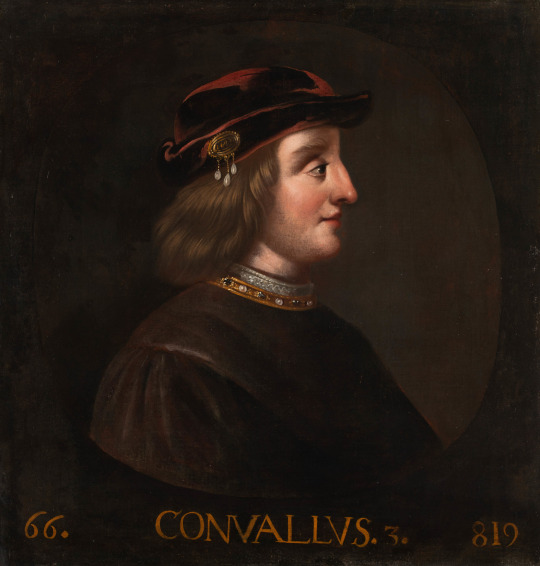
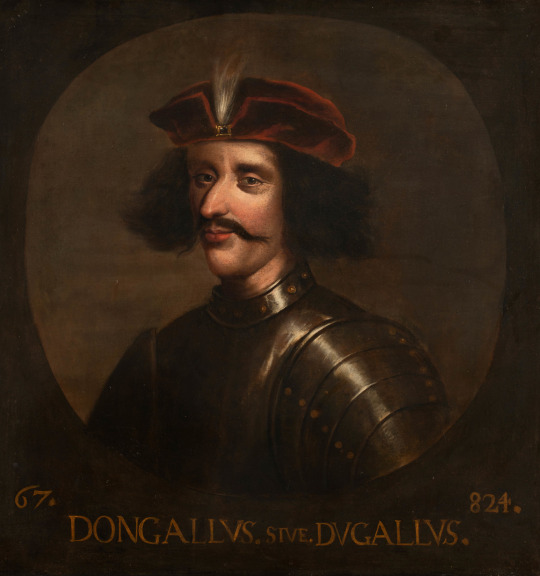
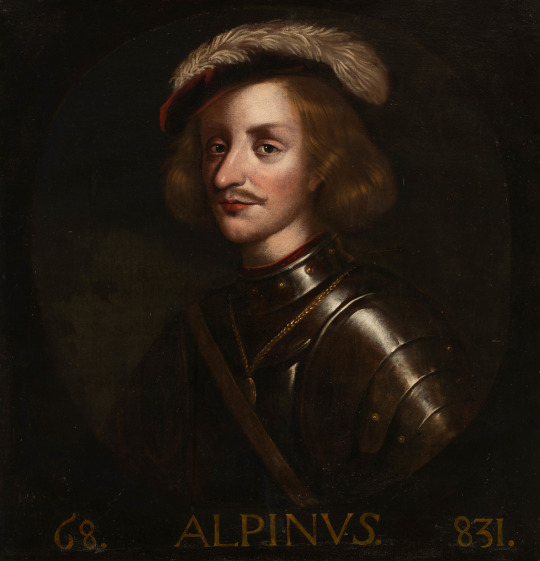
Legendary Kings of Scotland by James de Witt.
66: Congallus III or Convallus II (Conall Crandomna). He was king of Dál Riata (modern western Scotland) from about 650 until 660.
The Senchus fer n-Alban (an Old Irish medieval text) makes him a son of Eochaid Buide and thus a member of the Cenél nGabráin. He was co-ruler with Dúnchad mac Conaing until 654, after which he was apparently sole ruler.
His sons Máel Dúin mac Conaill and Domnall Donn may have been kings of Dál Riata.
His death in 659 or 660 is reported by the Annals of Ulster.
67: Dongallus (Domangart mac Domnaill). It is not clear whether he was king of Dál Riata or king of the Cenél nGabráin (the Cenél nGabráin was a kingroup, presumed to descend from Gabrán mac Domangairt, which dominated the kingship of Dál Riata until the late 7th century and continued to provide kings thereafter.)
68: Alpinus (Alpín mac Echdach). Cináed and Alpín are the names of Pictish kings in the 8th century: the brothers Ciniod and Elphin who ruled from 763 to 780.
Weir states that Alpín succeeded his father Eochaid IV as King 'of Scotland' (Dál Riata), and also became King of Kintyre in March/August 834, thus establishing his power over a wide area of Scotland.
Alpín died on 20 July or in August 834 when he was either killed whilst fighting the Picts in Galloway or beheaded after the battle. His place of burial is not recorded. He was succeeded by his son Kenneth MacAlpin.
#Conall Crandomna#dongallus#domangart mac domnaill#alpinus#alpin mac echdach#legendary kings of scotland#george buchanan#jacob jacobsz de wet ii#list of scottish kings#list of monarchs#rerum scoticarum historia#scottish history#de iure regni apus scotos#Chronicle of the Kings of Dál Riata#kings of dál riata#kingdom of dalriada#kings of the picts#scottish dna
6 notes
·
View notes
Text
John and Yoko and Beatles Docs Headed to Venice
At the Venice Film Festival next month, there are two documentaries premiering that have my attention immediately:
One to One: John & Yoko directed by Kevin Macdonald (The Last King of Scotland) is "a moving look at the couple's life upon their entry into a transformative 1970's New York, exploring their musical, personal, artistic, social, and political world." It's produced by Brad Pitt and his production company. It will feature personal archives from John and Yoko and features remixed concert audio from Sean Ono Lennon.
Things We Said Today from Romanian director Andrei Ujica looks at the band's first North American tour in 1964. Ron Howard's excellent 2016 documentary The Beatles: Eight Days a Week - The Touring Years looked at their touring era from 1962-1966, but this one seems to focus just on that very first tour when Beatle-mania hit the U.S. for the first time.
The link above is the article from Hollywood Reporter.
#the beatles#john lennon#yoko ono#sean lennon#documentary#venice film festival#movie news#film geek#kevin macdonald#brad pitt#andrei ujica
3 notes
·
View notes
Text
"Stone of Destiny" set to cause a stir

Press and Journal: October 4, 2008
Some say it was the greatest robbery in Scotland's History, others that it bolstered calls for independence. Now cinema audiences have the opportunity to decide for themselves as Stone of Destiny opens next week.
The true story of Scotland’s most daring robbery hits cinema screens on October 10, when Charles Martin Smith’s latest feature, Stone of Destiny, is released.
The all-star cast includes Charlie Cox (Casanova, Stardust) and Kate Mara (Shooter, Brokeback Mountain) alongside Scottish screen legends Billy Boyd (The Lord of the Rings, Master and Commander) and Robert Carlyle (Trainspotting, The Full Monty) as well as Peter Mullan (My Name is Joe, Children of Men) and Academy Award winner Brenda Fricker (My Left Foot).
Written and directed by Charles Martin Smith, Stone of Destiny is based on the real-life story of Ian Hamilton, played by Charlie Cox, who led a group of four university students to steal back the legendary coronation stone of Scottish kings and queens and symbol of Scottish independence – the Stone of Scone.
Frustrated by political apathy and Scotland’s diminishing sense of nationhood, Hamilton sought to reawaken Scottish national pride and spur his generation into action.
For hundreds of years, the English had jealously guarded the Scottish coronation stone, the Stone of Destiny – an ancient block of sandstone symbolically used in coronation ceremonies which Edward I took from Perth in the 13th century.
Hamilton led a group of university friends to London to make a dramatic gesture to reinstate Scotland’s place on the political map. Despite having little money and even less experience, they hatched an ambitious plan to break into Westminster Abbey in the wee hours of Christmas morning and “liberate” the most powerful symbol of Scotland’s nationhood, the Stone of Scone – otherwise known as the Stone of Destiny.
Hamilton’s daring act was a moment of great Scottish pride.
Based on Ian Hamilton’s book, The Taking of The Stone of Destiny, the movie was filmed in Glasgow and London and, fittingly, had its world premiere at the Edinburgh International Film Festival in June this year.
Among those attending the premiere were Sir Sean Connery, Nairn-based Oscar-winning actress Tilda Swinton and the entire cast.
While Charlie Cox burst into public consciousness in 2007 with his lead role in Matthew Vaughn’s Stardust, the 25-year-old London-born actor was no beginner.
After making his big-screen debut in 2003 thriller Dot The I, he went on to work opposite Al Pacino in Michael Radford’s lush film version of The Merchant of Venice and Heath Ledger in another film set in the Italian city, 2005’s Casanova. Subsequently acting alongside Robert De Niro and Michelle Pfeiffer in Stardust, Cox evidently has no fear of challenging himself to the limits.
However, accepting the role of Hamilton threw up two challenges – perfecting a Scottish accent and coming up against Scottish acting giant Robert Carlyle, who plays Hamilton’s reluctant mentor, John MacCormick.
Speaking of Carlyle, Cox said: “He’s one of my favourite actors; in many ways, more so than some of the big guys because he’s more my generation.
“I’ve grown up watching his films and he’s a jobbing actor who does great role after great role.”
And mastering the accent?
“Absolutely terrified – and still am. There’s no real excuse for it, is there? It’s my job to get it right, and I’m not great with accents. I’m not one of those people that can turn it on. I had to really work hard with it. And I know that I’ll watch the film and hear sounds that are off and wrong, and I just hope that doesn’t take away from the performance, and I hope it’s not too obvious to others.”
Having spent months filming a story he initially knew nothing about, it’s interesting to hear his views on the completed film.
“I loved it. I thought it was incredibly charming,” said Cox. “I felt like I did when I read the script. I thought it was a wonderful story and told brilliantly. And I really feel like Charlie Martin Smith has translated that very well on to film.”
Playing a person who is still alive makes the role that wee bit harder, too.
“It’s a bit mad, isn’t it?” said Cox. “It’s a wee bit more pressure. I feel, with the other characters that I’ve played, anything extra that I bring to it is justifiable because it’s my own invention. Whereas that’s not the case here.
“You’re playing someone who does exist, who was documented, and although what I know of Ian is what he is today, and the bits of information I have from the 1950s and the rest of his life, I don’t have any video footage of him. So I had to make my own mind up, which is more freeing.
“But it’s a pressure. If I don’t do him justice, if I get him wrong, it’s not OK. His son was on the set, who, ironically, is a friend of mine. Ian (Hamilton) has seen it, but not on the big screen, and that makes a big difference.
“If you don’t know much about film, if you haven’t worked a lot with film, you can watch it on a small screen and think that you’ve seen it. But then it’s a different experience.”
Like Mel Gibson’s Braveheart, Stone of Destiny is tipped to stir Scottish blood.
“I read something in the paper the other day. The biggest boost of national pride in Scotland over the last 50 years was the release of Braveheart,” said Cox. “They had more rallies and letters when Braveheart was released than over anything else.”
Although he knew nothing of the story beforehand, having learned it, Cox feels it contributed to the movement for Scottish independence.
“Although it didn’t have a direct impact into the Scottish government, it was certainly a huge catalyst towards all of that,” said Cox. “Ironically, and a lot of this is by chance, filming it now is interesting because the nationalist party are in power. Not only was that not the case back then, it was far from it. It was not even feasible.”
~*~
#just me archiving another old interview 😊#charlie cox#ian hamilton#stone of destiny 2008#interview#article#baby charlie
15 notes
·
View notes
Text



September 23rd 1779 saw the Battle of Flamborough Head.
The Battle of Flamborough Head is one of the most famous events to have taken place in the waters of the North Sea. In 1779 the American War of Independence spread to this unlikely location of on the Yorkshire coast of England
There was a joint Franco-American squadron, attempting to draw the British Home Fleet northwards so a joint Franco-Spanish invasion could take place in the south of England, when happened upon a large British convoy off Flamborough Head. Two Royal Navy ships, vastly outgunned by their French and American foes, saved the convoy, but were captured or sank in the act.
However, the real significance of the battle wasn’t about ships sunk, it became emblematic of the pluck and courage of the fledgling American nation. The American commander John Paul Jones, who was in fact a Scotsman sailing in a French ship, became known as ‘the father of the American Navy’. His ship, the Bonhomme Richard, despite being sunk during the battle, is now a legendary name in American naval history and to this day there is a USS Bonhomme Richard and a USS John Paul Jones serving in the US Navy.
Jone’s ship, USS Bonhomme Richard sank but before it went down he boarded and captured HMS Serapis. During the battle, Jones was famously reputed to have exclaimed “I have not yet begun to fight!” in response to the Royal Navy’s Captain Richard Pearson’s demand that he surrender his ship.
In recent years the wreck of the Bonhomme Richard has been found. It lies beneath the waves of Filey Bay and its discovery could lead to a tourism boom for the Yorkshire coast. The story of this battle is taught to every American schoolchild. It is big history a bit like were taught about........hm, The Battle of Hastings, which had nothing to do with Scotland! Aye well times are changing now and Scottish history is taught a lot more in school than was back in my days.
Scotland has an added interest in the area as on March 22nd 1406 the 8 year old Scottish King, James I, on his way to the safety of France, was captured by pirates off Flamborough Head, and delivered, or “sold” to the then King of England, Henry IV, he did not return home till 1424.
The pics are depictions of the battle, of which there are no shortage online, and a plaque at Filey, near where the Bonhomme Richard sank.
11 notes
·
View notes
Text
Girl Slaves of Morgana Le Fey (1971) is more than meets the eye!

🫦Mildly Erotic Eurotrash or film about life and death?💀

🧛♀️Yes the atmosphere is similar to Lesbian vampire films but the Dwarf is not Renfield from Dracula he’s from King Arthur’s Court.

🧚♀️Queen of Fairy is well known in Scotland (and even in the Scottish witch trials). This film resembles the great film Devil’s Widow (1970) with Ava Gardner - that is based on the Tam Lin, famous legend of the queen of fairy. 🇫🇷 has similar tales such as The Story of the Queen of the Flowery Isles - La Reine de l'isle des fleurs.

🛶Of course the oldest story behind this film is about Morgan le Fay, fairy enchantress of Arthurian legend and romance & Avalon, an island (with the boat) to which Britain’s legendary king Arthur was conveyed for the healing of his wounds after his final battle. It is first mentioned in Historia regum Britanniae (c. 1136). The island of ruled by the enchantress Morgan le Fay and her eight sisters, all of them skilled in the healing arts.

🎥 Morgan offers immortality and beauty; if the offer is not accepted, a life of abjection among a group of older women (crone) is the victim's lot. However the invitation is appealing.

🪦Immortality appears within psychoanalysis: for an uncanny excess of life, an ‘undead’ urge that persists beyond the (biological) cycle of life and death, generation and corruption.
🦄Oblivion 🍪, in a fairytale can be like the unlimited satisfaction of needs. Often, however, the hero finds his way back cleverly, or with the help of others. (Bettelheim 1987.) So here too. But when fantasy covers up a trauma, e.g. the loss of a mother, it can be like an attempt to keep parts of the mother alive forever.

🛋️Freud equates the death drive with the ‘so-called ‘compulsion-to-repeat’ an uncanny urge to repeat painful past experiences that seems to outgrow the natural limitations of the organism affected by it and to persist even beyond the organism’s death. (Žižek 2006, 62-63).

I❤️the visit of the morbid poet Louise Labé & the dancers during orgy + the Soundtrack
Beautiful scenery 🏰
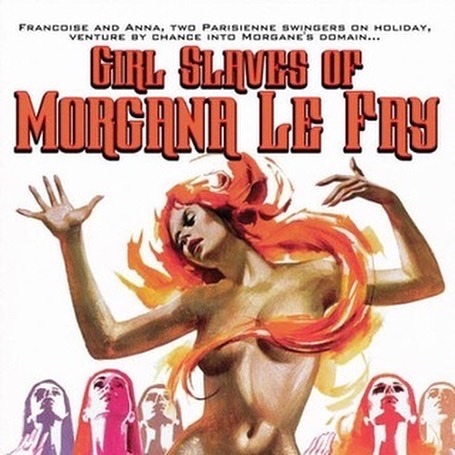
Soul Sanitarium review ⭐️⭐️⭐️⭐️ (a fantasy film/horror elements are missing, but not the usual Hollywood 💩) This is what Labyrinth (1986) could not show🙂

youtube
#witchcraft#movies#film#cinema#folklore#fantasy#morgana#dark fairytale#fairy tail#psychoanalysis#frechfilm#Witch#avalon#louise labé#oblivion#Youtube
2 notes
·
View notes
Photo

The Stuarts were also deeply lined to the land indeed, with all three lands. As with their continental counterparts, this link was partly historic, partly mythic. This was particularly true of the Stuarts:
Subsequently, it was to be “those who supported the Divine Right of Kings” who “upheld the historicity of Arthur;” whereas those who did not turned instead “to the laws and customs of the Anglo-Saxons.” Arthur remained a figure central to Stuart propaganda. Stuart iconography celebrated the habits and beliefs of the ancient Britons. In particular, the Royal Oak, still a central symbol of the dynasty, was closely related to ideas about Celtic fertility ritual, and the King’s power as an agent of renewal: “The oak, the largest and strongest tree in the North, was venerated by the Celts as a symbol of the supreme power.” It was thus fitting that an oak should protect Charles II from the Cromwellian troops who wished to strip the sacred new Arthur of his status. The story confirmed the King’s mystical authority, and also his close friendship with nature. Long after 1688, the Stuart dynasty was to be closely linked with images of fertility. In literature, Arthurian images of the Stuarts persisted into the nineteenth century. This “Welsh messiah, the warrior who will come to overthrow the Saxons and Normans,” was an icon of the Stuarts’ claim to be Kings of all Britain, both “Political Hero” and “National Messiah,” in Arthurian mould. Arthur’s status as a legendary huntsman (“the figure of the Wild Huntsman is sometimes identified with Arthur”) was also significant. The Stuarts made much of hunting: it helped to confirm their heroic status as stewards of nature and the land. In doing this, they identified themselves not only with Arthur, but with Fionn, the legendary Gaelic warlord who was in the eighteenth century to be the subject of James Macpherson’s pro-Stuart Ossian poems. Fionn, legends of whom abound in Scotland, was also, like Arthur, scheduled to wake and deliver the nation when danger threatened. In identifying with both figures, the Stuarts were able to simultaneously present themselves as Gaelic and British monarchs. This symbolism was used with peculiar adroitness in Ireland, where the Stuarts were almost never identified with Arthur, but rather with Fionn and heroes from Fionn’s own time. Charles Edward was compared to Fergus, Conall, Conroy, and Angus Oge, while his grandfather became for some a symbol of Ireland herself, a Fenian hero in the making, a foreshadower of the sacrificial politics of such as Pearse: “Righ Shemus, King James, represented the faith of Erin, and so became her comrade in martyrdom.” In famous eighteenth century songs like “the Blackbird,” Ireland was presented as an abandoned woman, waiting for the return of her hero-King. The same symbolism was used in Scotland. “The Gaelic messianic tradition” of Fionn suggested that the Stuart King would one day return to bring light and fecundity to the land. In the Highlands of Scotland, the events of Jacobitism themselves passed into folklore, like the older stories to which they were related. More educated Jacobite sympathisers compared the Stuarts to the heroes of the Roman Republic, to Aeneas, or to the saints. But the view of them as sacred monarchs of folkloric tradition and power was one which endured among all ranks (Murray G.H. Pittock, The Invention of Scotland, pp. 4-5).
On the one hand, such Kings –and the Stuarts in particular – were not only connected to the land, they were its stewards – hunters, guardians of the forest, promoters of agriculture (this is why there are so many national – formerly Royal – stud farms, sheep folds, and cattle pens across Europe).
6 notes
·
View notes